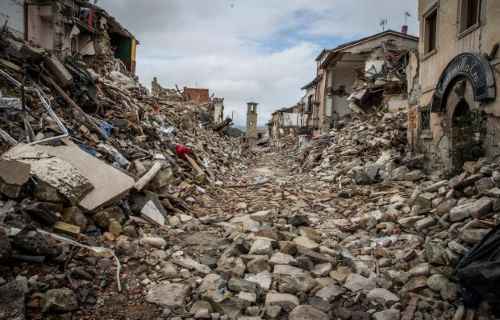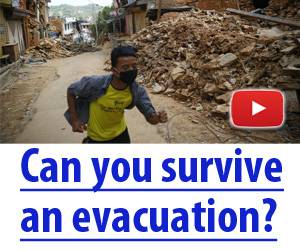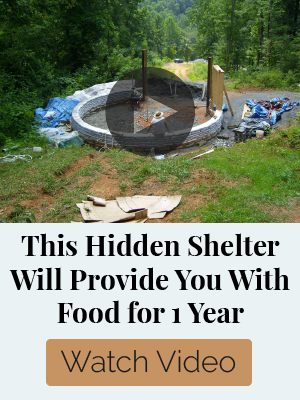
Earthquakes happen anywhere, any time, and without any warning, so preparing is key
Earthquakes are abrupt, devastating and disastrous, and what makes them worse is that they happen in an instant, without warning, anytime, anywhere.
Originally published: thepreppingguide – By Jennifer
It is because of this that many residents in ‘high risk’ areas should know what to do during an earthquake, as well as how to prepare for an earthquake, should it ever happen.
As dangerous and destructive as they are, there are a few things you can do to both minimize your risks, as well as lessen the impact an earthquake may have on your family during and after the event, so in this post, we look at how to prepare for an earthquake to ensure you are ready for the worst.
While earthquakes do happen all over the world, there are some more high-risk areas where earthquakes are more likely to happen.
According to Earthquakes Report, the top 5 high-risk earthquake areas in the US are:
- Alaska
- California
- Hawaii
- Nevada
- Washington
Chances are, if you are living in one of these areas, you would have already experienced tremors, shaking, or a complete earthquake already. We can also see the hazard areas for earthquakes marked on this map below.

That is not to say that earthquakes do not happen anywhere else. They do, and they strike at any time. Unfortunately, for some of us, we can’t help but live in these high-risk areas, whether it be for work, family, or because it’s just where we grew up and we refuse to leave our home.
In any case, knowing what to do when an earthquake occurs will greatly minimize your risks, and increase the chances of survival for yourself, and those around you.
So let’s take a look at what you should do in an earthquake.
1. What to do in an earthquake

Earthquakes, as you are well aware, cause buildings to collapse, crumble and turn heavy objects into dangerous instruments that can trap you, injure you, or kill you.
That’s the primary effects of an earthquake, however, earthquakes also have secondary effects, such as:
- Causing fires
- Damaging roads and leaving you stranded or without exit points
- Cause tsunamis and flooding
- Cause the shutdown of many integral systems such as water, the grid, and supplies such as food and medicine
During an earthquake, there is a very simple rule that people are taught, which is: drop, cover, and hold on. This is to ensure that whatever happens, you seek immediate protection during an earthquake. For instance:
- If you are in a vehicle when an earthquake occurs, pull over and stop in a space clear of trees, buildings, bridges and power lines. Do not drive through it.
- If you are in bed, stay in it and cover your head and neck with pillows.
- If you are outdoors, stay outdoors. Do not run to a building.
- Do not stand in a doorway. It will likely crumble and trap you.
- Do not run outside.
The motto: drop, cover, and hold on, is taught in schools and businesses in high-risk areas to ensure that people stay where they are and protect themselves in an earthquake.
The reason why authorities alert people to not running out of a building during an earthquake is that the greatest danger of an earthquake exists directly outside buildings, exterior walls, and exits to any establishment.
Research from the University of Washington shows that the majority of injuries and fatalities occur during an earthquake when people either:
- Run outside or to other rooms during shaking
- Standing in doorways
- Getting into a “triangle of life”
Doing these things will likely get you killed, so don’t do them.
2. Things you should do before an earthquake

Preparing for an earthquake largely revolves around the right knowledge of what to do. However, there are some things that you should do around the home to make sure there are less risks. This is especially the case if you live in one of the high-risk areas we pointed out at the beginning of this article.
So how can you prepare now, for something that you can’t predict will happen? Easy. Based on past research of what happens in earthquakes, there are a number of things you should do to prepare for the next one. They are:
- Secure large and loose objects in the family home that may cause injury to yourself or others. These would be things such as making sure your television set is secure, any large items on shelves are secure, and storing breakable glass items in lower shelves to minimize their chance of breaking.
- Create a communication plan for your family/friends. This would be simple things such as having a place to go to that’s away from the area (bug out location) alternative ways to get there, and an out-of-area contact.
- Practice the drop, cover, and hold on routine with your family and coworkers. Having at least one person in a group will ensure that anyone else around them will remain safe.
- Make sure your home and contents insurance covers damage caused during an earthquake.
- Get together supplies that you might need after the impact of an earthquake. We will look at this below in further detail.
Other ways to prepare your area
Other things you can do, that are more specific to your area or home, are:
- Be familiarized with the fire evacuation and earthquake plans for all of the buildings that you always occupy
- Choose a safe part in each room of your home, school or workplace. A safe place must be under a piece of furniture or against an interior wall away from bookcases, windows, or tall furniture that could fall on you.
- Ensure your home is strengthened and anchored to its foundation
- Secure a flashlight and sturdy shoes by each individual’s bed.
- Secure and maintain an emergency supply kit in an easy-to-access location
- Bolt and brace water heaters and gas appliances to wall studs
- Strengthen overhead light.
- Bolt bookcases, china cabinets and other tall furniture to wall studs
- Know your area’s seismic building standards and land use codes before starting a new construction
- Know how to shut off the gas valves in your home and keep a wrench-handy for that purpose
- Install strong latches or bolts on cabinets heavy and large items should be closest to the floor
When it comes to an earthquake survival kit, as mentioned, make sure it is in an easy to locate area. This might be a central part of the house that you can reach after an earthquake has happened. Now let’s look at what you should keep in a survival kit for earthquakes.
3. What to pack in an earthquake survival kit

So you’ve got yourself and anyone around you ready for an earthquake. But what do you need after an earthquake has happened?
The items we have recommended are basic prepper supplies that you can easily get on any budget. For the essentials, here are some items you should consider packing into an earthquake survival kit:
- Food to last at least three days for each person you have in your home
- Water to last at least three days for each person
- A flashlight with extra batteries for when the power goes out, as well as to assist in any search attempts through rubble, should the earthquake be destructive
- A fire extinguisher for any possible fires that may occur
- A whistle so that should you be trapped in a building, you don’t increase your thirst by yelling out and instead can make a high-pitched whistle sound for search parties and rescue dogs.
- Any medication you might need
- A power bank or battery pack for your phone to call for help
- A hand-crank (or battery powered) radio
- A first-aid kit to deal with any minor injuries
- Sanitation items for personal cleaning, hygiene, and of course toilet paper (you can also use toilet paper tablets)
- If you have any pets, consider their needs for water, food and a toy or mat for their comfort as well
Things that will help post-earthquake
There are some added extras you might want to consider, that while they might not be life-saving, can go a long way to helping you out. They are:
- Medical supplies (hearing aids with extra batteries, glasses, extra contact lenses, etc)
- Baby supplies (bottles, formula, baby food, diapers)
- Games and activities for children
- Pet supplies (collar, leash, ID, food, carrier, bowl)
- Two-way radios
- Extra set of car keys and house keys
- Manual can opener (especially if you’ve stocked tin food in your food supply)
- A multitool (should be an everyday carry item, but just in case, it will definitely help)
- A simple N95 breathing mask or dust mask for dust fibers and possible smoke
Maintaining your earthquake survival kit
After you have assembled your kit, it is also important to maintain it so that it is always ready when you need it. You can do this simply by:
- Keeping canned food in a cool, dry place
- Store boxed food in tightly closed plastic or metal containers
- Replace expired items as needed
- Re-think your needs every year and update your kit as your family’s needs change.
Making sure you have an earthquake survival kit wherever you are
As we know, an earthquake can and does happen anywhere, at any time. Therefore, since you do not know where you will be when an emergency occurs, prepare supplies for home, work and the family car.
- Home: Make sure all family members know where the kit is kept. Keep this kit in a designated place and have it ready in case you have to leave your home quickly.
- Work: Be prepared to shelter at work for at least 24 hours. Your work kit should include food, water and other necessities like medicines, as well as comfortable walking shoes, stored in a “grab and go” case or bug out bag.
- Vehicle: In case you are stranded, keep a kit of emergency supplies in your car.
Now that we have the right essentials to increase our chances of survival after an earthquake, let’s take a look at what to do after an earthquake has occurred.
4. What to do after an earthquake has happened

Once an earthquake has occurred, there are a number of dangers and risks that might happen, depending upon the extremity and magnitude and the event that happened.
Just because the earthquake has happened, it is not over. There may be more earthquakes, a possible tsunami, or multiple other associated risks that you need to be wary of.
As a general response to an earthquake, the following points cover what you should do, post-event:
- Prepare and expect for potential aftershocks, landslides or even tsunamis. A tsunami or tidal wave is regularly produced after an earthquake in coastal areas
- Even if you felt aftershocks, still drop, cover and hold on. Aftershocks are little trembles that occur minutes, days, weeks even months after the “main tremble” or the earthquake
- Check yourself first to see if you have been injured and apply first-aid if needed. This is a priority before you help other injured or trapped people
- Put on a long-sleeved shirt, long pants, sturdy shoes and work gloves to protect against injury from broken objects.
- Look for damage in and around your home quickly. Check around your home and get everyone out if your home is unsafe.
- Search for, and extinguish, small fires. Fire is a common hazard after an earthquake and can become very bad, very quickly.
- Open your cabinet doors and closet carefully as contents may have shifted.
- Be watchful for broken gas lines or fallen power lines and stay out of damaged areas
- Stay away from damaged buildings.
- Help people who need special help such as infants, children and elderly or disabled.
- Keep animals under your direct control.
- Listen to a portable, battery-operated or hand-crank radio for updated emergency information and instructions.
- Check to telephones in your workplace in your home to see if you can still make a call. Make a brief calls to report life-threatening emergencies.
While these points cover what to do during an earthquake, preparation is the key to maximizing your chances of survival. This is why, ultimately, running through these easy points, and making some easy and generally free preparations, in life, will make sure that you suffer less, later, should an earthquake happen.

5. Anywhere, any time, without any warning
The danger is that earthquakes can happen at any time, without any warning. And although they may only last for less than one minute, there is no way to predict their strength or the after-effect of any possible flooding, fires, or other related hazards.
With the large number of earthquakes the United States experiences, it is that much more important that all of your family members, especially children, are well-versed in how to react correctly and quickly during an earthquake, and that you make the right preparations in advance for such an event.
It is not much to remember, but if you so remember these steps, you will be a lot safer when an earthquake hits.
Do you know about the gift of nature to save the life of people from various health problems and make them feel secure by curing significant issues? How to live healthy in this world without having chronic diseases or illness or any other health issues which may hurt you physically and mentally? Due to dense population, people are trying to demolish the forest, garden areas to create shelter, so they forced to destroy the nature’s gift such as natural ingredients, secret medicinal herbs and more which are grown in wild forest, mountains and other places. When you read this review entirely, sure you will get chance to know about secrets medicinal ingredients, herbs and more used by our ancestor to get back the lost health without losing your life. Claude Davis was highlighted all the stuff in the form of the e-book The Lost Book Of Remedies filled with a list of natural ingredients and remedies that you can quickly grow in the backyard or at free space to include it in your routine diet or external usage to get well soon.
Books can be your best pre-collapse investment.
Carnivore’s Bible (is a wellknown meat processor providing custom meat processing services locally andacross the state of Montana and more. Whether your needs are for domestic meator wild game meat processing)
The Lost Book of Remedies PDF ( contains a series of medicinal andherbal recipes to make home made remedies from medicinal plants and herbs.Chromic diseases and maladies can be overcome by taking the remediesoutlined in this book. The writer claims that his grandfather was taughtherbalism and healing whilst in active service during world war twoand that he has treated many soldiers with his home made cures. )
Easy Cellar(Info about building and managing your root cellar, plus printable plans. The book on building and using root cellars – The Complete Root Cellar Book.)
The Lost Ways (Learn the long forgotten secrets that helped our forefathers survive famines,wars,economic crisis and anything else life threw at them)
LOST WAYS 2 ( Wordof the day: Prepare! And do it the old fashion way, like our fore-fathers did it and succeed longbefore us,because what lies ahead of us will require all the help we can get. Watch this video and learn the 3 skills that ensured our ancestors survival in hard times offamine and war.)
Survival MD (Best Post Collapse First Aid Survival Guide Ever)
Conquering the coming collapse (Financial advice and preparedness )
Liberty Generator (Build and make your own energy source)
Backyard Liberty (Easy and cheap DIY Aquaponic system to grow your organic and living food bank)
Bullet Proof Home (A Prepper’s Guide in Safeguarding a Home )
Family Self Defense (Best Self Defense Strategies For You And Your Family)
Survive Any Crisis (Best Items To Hoard For A Long Term Crisis)
Survive The End Days(Biggest Cover Up Of Our President)
About the author

Jennifer Moran is the author and the social media manager at PreparedBee.com. She has been working as a writer for more than four years. When she isn’t glued to a laptop screen, she spends time playing with her child, playing tennis, practicing yoga, and trying very hard not to sleep while meditating.


